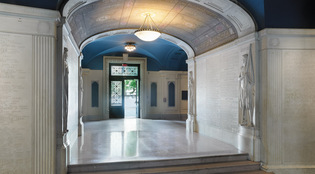 loading
loading
features"The mingled dust of both armies"Yale's Civil War memorial remembers all who died. But it forgets what the war was about. Ali Frick ’07, ’12JD, a third-year law student at Yale, wrote her senior essay on Yale’s Civil War memorial.  Christopher GardnerThe names on the original memorial in the archway have been joined by those of hundreds more Yale alumni (on the walls to the left and right in photo) who died in wars before and after the Civil War. View full image
Almost every Yale student has passed through it, though probably few are aware of its original purpose. It adorns one of the most trafficked arteries on campus: the corridor that connects Woolsey Hall and Commons with the rotunda of Memorial Hall, and links the central campus to Science Hill. It is Yale’s Civil War Memorial, dedicated in 1915, 50 years after Grant and Lee shook hands at Appomattox. Filling the two walls of the short hallway, the monument lists the names of Yale men who died during the war, with their army rankings and the place and year of each man’s death. The walls are framed by four high-relief statues, signifying Courage, Devotion, Memory, and Peace; on the floor are engraved a stanza of an elegiac poem and a dedication, consecrating the memorial to “the men of Yale who gave their lives in the Civil War.” It would be a fairly conventional memorial, except for one striking feature: it includes the names of both Confederate and Union dead. Some four decades earlier, Yale’s peer institutions in New England had completed their own monuments, honoring only their Union dead: Brown in 1866, and Harvard in 1874. For their part, universities in the South memorialized fallen soldiers of the Confederacy; the 1885 marble tablets in the University of North Carolina’s Memorial Hall are inscribed with the school’s “Roll of Confederate Dead.” Yale had considered creating a memorial to its Union soldiers in 1865, but the idea was soon forgotten or abandoned. By the time Yale finally acted, the national conception of the war had changed dramatically, and Yale’s memorial reflects the revised view of the conflict as a great struggle between two noble armies. By grouping Northern and Southern names together on Yale’s walls, the university aimed to pay tribute to the heroism of both sides. Today the memorial is surrounded by much longer lists, added later, of Yale alumni killed in other wars, and its Civil War origins can scarcely be perceived. But the group of alumni who created it labored for six years over its design, its placement, and its purpose. They saw the monument as a message of national healing, both reflecting and promoting the renewed bonds between North and South. The committee’s papers, housed in the manuscripts and archives department at the Yale University Library, tell the story of how this monument came to be—how a Connecticut university, with an overwhelmingly Northern, pro-Lincoln, and anti-slavery student body in the 1860s, came to dedicate a memorial that, as its inscription reads, bestows “Love and tears for the Blue / Tears and love for the Gray.”
Students who attended Yale during the Civil War would likely have found the monument’s homage to both sides perplexing. At the time, few Southern students had ever attended Yale, and very few were there during the Civil War: the percentage of Southern students in the college had peaked at 12.78 percent during 1845–46, but dropped to 3.23 percent by 1860–61. Yale president Theodore Dwight Woolsey ’20, whose statue overlooks Old Campus today, was unabashedly anti-slavery; he hoped that secession and its consequences would prove “the greatest stab to slavery that could be received.” A campus poll conducted by the Yale Literary Magazine prior to the 1864 presidential election found 372 supporters of President Abraham Lincoln—who had by then issued the Emancipation Proclamation and was fighting a war to sustain it—and only 96 supporters of General George McClellan, the Democratic candidate. Poems and editorials in the magazine expressed abhorrence of slavery and praised students who had left their studies to “fight for freedom.” Yale men answered the call to battle in great numbers. In all, at least 737 Yale men, from all schools and all class years, served in the US military during the war—including, for example, more than a third of the Class of 1858. At the 1865 commencement ceremonies, dedicated to celebrating the Union “heroes of Yale,” the principal speaker declared, “We owe it to the memory of our dead to extirpate and sweep away every vestige of slavery.” But by the turn of the century, the nation was engaged in what Yale historian David Blight describes as an effort of reconciliationist memory, “disembodied from the causes and consequences of the war.” Racing toward national reunion, the two sides were forced to overlook the specific causes that had torn them apart in the first place. The memory of slavery and emancipation, Blight writes, “never fit well into a developing narrative in which the Old and New South were romanticized and welcomed back to a new nationalism, and in which devotion alone made everyone right, and no one truly wrong, in the remembered Civil War.” It was in this national spirit of reconciliation that Yale revived the idea of building a memorial. When Judge Henry E. Howland ’54 proposed such a memorial in 1909, he admitted that, directly after the war, “it would have been ill-timed to have suggested that sons of the South should have been remembered in such a memorial. But now,” he continued, “when the passions of that time have died away … it seems an appropriate moment to bring before the alumni of Yale the propriety of commemorating the men of both sides who gave their lives in the great struggle.”
|
|